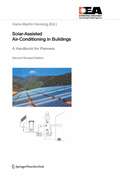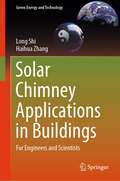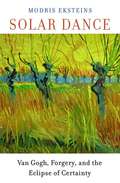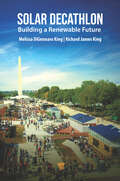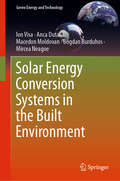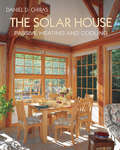- Table View
- List View
Solar Air Systems - Built Examples
by Robert HastingsThirty-five different buildings with successfully installed solar air systems are described and documented. The building types cover single family houses, apartment buildings, schools, sports halls, and industrial commercial buildings with six different configurations of solar air systems used. Each example building is described over several pages, with plans, performance details and illustrations provided. This is supplemented by a summary of the types of system used.
Solar Architecture in Cool Climates
by Colin Porteous'A must-read for practitioners, teachers and others interested in or working with energy use in the built environment, including a delightful set of examples' Ann Grete Hestnes, former President of the International Solar Energy Society Solar Architecture in Cool Climates is an invaluable primer on low energy building design, combining accessible information with convincing arguments enabling new techniques to be implemented in daily practice. Approaching the topic in a thematic manner, the book provides inspiration, an understanding of key principles and technical data on the design of solar buildings in higher latitudes. The text is enlivened through direct experience of case studies from Europe and North America dealing with new-build, retrofitting and conceptual projects that outline future potential (the principles being equally applicable to equivalent southern latitude locations. The authors examine the dilution of additional costs through different strategies, the tensions between energy efficiency and environmental quality, and the proactive control of energy in building design. Promoting flexibility and opportunity to a diverse audience, including those who use, procure and finance buildings, the book aims to bring the design of 'green' solar buildings in cool climates from special interest status into the mainstream. Broader environmental issues relating to solar architecture are addressed in the final chapter, again drawing on case studies from the authors' own wide experience. Solar Architecture in Cool Climates is written for architects and other building designers, students of architecture and other professionals interested in sustainable architecture, renewable energy and engineering.
Solar Architecture in Cool Climates
by Colin Porteous'A must-read for practitioners, teachers and others interested in or working with energy use in the built environment, including a delightful set of examples' Ann Grete Hestnes, former President of the International Solar Energy Society Solar Architecture in Cool Climates is an invaluable primer on low energy building design, combining accessible information with convincing arguments enabling new techniques to be implemented in daily practice. Approaching the topic in a thematic manner, the book provides inspiration, an understanding of key principles and technical data on the design of solar buildings in higher latitudes. The text is enlivened through direct experience of case studies from Europe and North America dealing with new-build, retrofitting and conceptual projects that outline future potential (the principles being equally applicable to equivalent southern latitude locations. The authors examine the dilution of additional costs through different strategies, the tensions between energy efficiency and environmental quality, and the proactive control of energy in building design. Promoting flexibility and opportunity to a diverse audience, including those who use, procure and finance buildings, the book aims to bring the design of 'green' solar buildings in cool climates from special interest status into the mainstream. Broader environmental issues relating to solar architecture are addressed in the final chapter, again drawing on case studies from the authors' own wide experience. Solar Architecture in Cool Climates is written for architects and other building designers, students of architecture and other professionals interested in sustainable architecture, renewable energy and engineering.
Solar-Assisted Air-Conditioning in Buildings: A Handbook for Planners
Air conditioning contributes significantly to the energy consumption of buildings in many countries. A promising possibility for energy reduction is the use of solar thermal energy in solar-assisted air conditioning systems. The main advantage of this technology is that cooling loads and solar gains occur at the same time, at least on a seasonal level. However, until today only a few systems have been installed world-wide and design and operation experiences are fairly poor. The goal of this handbook - meanwhile available in the 2nd edition - is to address this lack and to support the planner in the design of solar assisted air-conditioning systems, which use solar collectors as heat source.
Solar Buildings and Neighborhoods: Design Considerations for High Energy Performance (Green Energy and Technology)
by Caroline Hachem-VermetteThis book presents the main principles for designing buildings and neighborhoods with increased potential to capture and utilize solar energy. It discusses practical issues in the design of the built environment and their impact on energy performance; and a range of design considerations, from building components (e.g. the building envelope) to urban planning issues (e.g. density and street layouts). In addition to design guidelines on how to increase buildings’ potential to capture solar energy, the book provides creative tips to increase the aesthetic value of solar technology integration in buildings. Helping readers plan energy-efficient buildings with innovative building envelope technologies, and to understand the impact of early-stage design considerations on the energy performance of buildings and communities, the book offers a valuable source of information for building professionals, including architects, engineers, and urban planners. It can also serve as a reference guide for academics and students of energy efficiency in buildings and urban planning.
Solar Chimney Applications in Buildings: For Engineers and Scientists (Green Energy and Technology)
by Long Shi Haihua ZhangThis book comprehensively describes the operating principles and theoretical foundations of solar chimneys. It covers current research results, including numerical analysis and mathematical models based on different assumptions. Complying with the application of renewable energy in sustainable buildings, solar chimney has received extensive attention as an indispensable part natural ventilation. This book is a guide to the application of solar chimneys from single zones to multi zones, and it provides a reference source of application for construction practitioners and engineering decision-makers. The design basis and the related basic principles of fluid mechanics and natural ventilation design strategies introduced in this book will also be beneficial to college students.
Solar Dance: Van Gogh, Forgery, And The Eclipse Of Certainty
by Modris EksteinsArt dealer Otto Wacker’s 1932 sensational trial in Berlin for selling fake Van Goghs leads Eksteins to a unique narrative of a collapsing Weimar Germany, the rise of another misfit, Adolf Hitler, and the replacement of nineteenth-century certitude with twentieth-century doubt.
Solar Dance: Van Gogh, Forgery, And The Eclipse Of Certainty
by Modris EksteinsArt dealer Otto Wacker’s 1932 sensational trial in Berlin for selling fake Van Goghs leads Eksteins to a unique narrative of a collapsing Weimar Germany, the rise of another misfit, Adolf Hitler, and the replacement of nineteenth-century certitude with twentieth-century doubt.
Solar Decathlon: Building a Renewable Future
by Melissa DiGennaro King Richard James KingThis book is an inspirational story about how an idea got started, hit the ground running, and took flight. Solar Decathlon (SD) was a response to the need for innovative solutions to address a global problem—climate change. Richard King believed a collegiate competition that encouraged creative ingenuity could help transform traditional ways of designing and building houses. His idea was to motivate students to work together to craft unique sustainable, net-zero energy dwellings. Competing teams would display their prototypes in a single location as an educational showcase to the public. Following the inaugural competition and recurring events in Washington, DC, SD spread to multiple locations around the world. This historical narrative with stunning photos is a comprehensive source of information about the inception, development, and growth of Solar Decathlon.
Solar Decathlon: Building a Renewable Future
by Melissa DiGennaro King Richard James KingThis book is an inspirational story about how an idea got started, hit the ground running, and took flight. Solar Decathlon (SD) was a response to the need for innovative solutions to address a global problem—climate change. Richard King believed a collegiate competition that encouraged creative ingenuity could help transform traditional ways of designing and building houses. His idea was to motivate students to work together to craft unique sustainable, net-zero energy dwellings. Competing teams would display their prototypes in a single location as an educational showcase to the public. Following the inaugural competition and recurring events in Washington, DC, SD spread to multiple locations around the world. This historical narrative with stunning photos is a comprehensive source of information about the inception, development, and growth of Solar Decathlon.
Solar Energy: Technologies and Project Delivery for Buildings (RSMeans)
by Andy WalkerSolar Energy is an authoritative reference on the design of solar energy systems in building projects, with applications, operating principles, and simple tools for the construction, engineering, and design professional. The book simplifies the solar design and engineering process, providing sample documentation and special tools that provide all the information needed for the complete design of a solar energy system for buildings to enable mainstream MEP and design firms, and not just solar energy specialists, to meet the growing demand for solar energy systems in building projects.
Solar Energy: Technologies and Project Delivery for Buildings (RSMeans)
by Andy WalkerSolar Energy is an authoritative reference on the design of solar energy systems in building projects, with applications, operating principles, and simple tools for the construction, engineering, and design professional. The book simplifies the solar design and engineering process, providing sample documentation and special tools that provide all the information needed for the complete design of a solar energy system for buildings to enable mainstream MEP and design firms, and not just solar energy specialists, to meet the growing demand for solar energy systems in building projects.
Solar Energy Conversion in Communities: Proceedings of the Conference for Sustainable Energy (CSE) 2020 (Springer Proceedings in Energy)
by Ion Visa Anca DutaThis book presents novel findings concerning the systems, materials and processes used in solar energy conversion in communities. It begins with the core resource – solar radiation – and discusses the restrictions on the wide-scale implementation of conversion systems imposed by the built environment, as well as potential solutions. The book also describes efficient solar energy conversion in detail, focusing on heat and electricity production in communities and water reuse. Lastly, it analyzes the concept of sustainable communities, presenting examples from around the globe, along with novel approaches to improving their feasibility and affordability. Though chiefly intended for professionals working in the field of sustainability at the community level, the book will also be of interest to researchers, academics and doctoral students.
Solar Energy Conversion Systems in the Built Environment (Green Energy and Technology)
by Ion Visa Anca Duta Macedon Moldovan Bogdan Burduhos Mircea NeagoeThis book focuses on solar energy conversion systems that can be implemented in the built environment, at building or at community level. The quest for developing a sustainable built environment asks for specific solutions to provide clean energy based on renewable sources, and solar energy is considered one of the cleanest available energy on Earth. The specific issues raised by the implementation location are discussed, including the climatic profile distorted by the buildings, the available surface on the buildings for implementation, etc. This book also discusses the seasonal and diurnal variability of the solar energy resource in parallel with the variability of the electrical and thermal energy demand in the built environment (particularly focusing on the residential buildings). Solutions are proposed to match these variabilities, including the development of energy mixes with other renewables (e.g. geothermal or biomass, for thermal energy production). Specific solutions, including case studies of systems implemented on buildings all over the world, are presented and analyzed for electrical and for thermal energy production and the main differences in the systems design are outlined. The conversion efficiency (thus the output) and the main causes of energy losses are considered in both cases. The architectural constraints are additionally considered and novel solar energy convertors with different shapes and colors are presented and discussed. The durability of the solar energy conversion systems is analyzed considering the specific issues that occur when these systems are implemented in the built environment; based on practical examples, general conclusions are formulated and specific aspects are discussed in relation to experimental results and literature data. With renewables implemented in the built environment likely to expand in the near future, this book represents welcome and timely material for all professionals and researchers that are aiming to provide efficient and feasible solutions for the sustainable built environment.
Solar Energy Houses: Strategies, Technologies, Examples
by Anne-Grete Hestnes Robert Hastings Bjarne SaxhofPassive and active solar strategies together with the adoption of energy conservation measures and the integration of new materials and technologies can lead to a dramatic reduction of 75-90 per cent in the energy consumption of the buildings. The objective of Task 13 of the IEA's Solar Heating and Cooling Programme was to advance solar building technologies and demonstrate this potential by designing and constructing buildings that met very low energy consumption targets while maintaining a good indoor climate. This revised second edition of this book presents the findings of the Task 13 experts and includes the results of the monitoring programme, conducted to determine the effectives of the techniques and strategies adopted. This new edition also provides a detailed explanation of this research programme in terms of how far the expectations of the Task experts were met and highlights the specific successes and lessons learned from the project.
Solar Energy Houses: Strategies, Technologies, Examples
by Anne-Grete Hestnes Robert Hastings Bjarne SaxhofPassive and active solar strategies together with the adoption of energy conservation measures and the integration of new materials and technologies can lead to a dramatic reduction of 75-90 per cent in the energy consumption of the buildings. The objective of Task 13 of the IEA's Solar Heating and Cooling Programme was to advance solar building technologies and demonstrate this potential by designing and constructing buildings that met very low energy consumption targets while maintaining a good indoor climate. This revised second edition of this book presents the findings of the Task 13 experts and includes the results of the monitoring programme, conducted to determine the effectives of the techniques and strategies adopted. This new edition also provides a detailed explanation of this research programme in terms of how far the expectations of the Task experts were met and highlights the specific successes and lessons learned from the project.
Solar Home Design Manual for Cool Climates
by Shawna Henderson Don RoscoeIf you want an inexpensive, environmentally sound source of energy for your home, you need look no further than the sun. Solar heat is not subject to rate increases, is totally renewable, pollution free and requires little or no technology. It is here for you today, and can easily provide up to 50% of your space and water heating requirements. This is a book that simply and clearly explains the principles of using solar energy to heat your home. Anyone building a new home, or renovating an old one can incorporate one or several aspects of solar energy into their design. Taking you through the process of designing a solar home from the ground up this manual is also a basic course in conservation and sustainable house design. If you live in a 'heating' climate, meaning if you have space heating requirements for most of the year then this is an invaluable resource. A house is the biggest single investment most of us will make in our lives - the way it is built and how it operates can reflect a long term investment in both the building and the planet.
Solar Home Design Manual for Cool Climates
by Shawna Henderson Don RoscoeIf you want an inexpensive, environmentally sound source of energy for your home, you need look no further than the sun. Solar heat is not subject to rate increases, is totally renewable, pollution free and requires little or no technology. It is here for you today, and can easily provide up to 50% of your space and water heating requirements. This is a book that simply and clearly explains the principles of using solar energy to heat your home. Anyone building a new home, or renovating an old one can incorporate one or several aspects of solar energy into their design. Taking you through the process of designing a solar home from the ground up this manual is also a basic course in conservation and sustainable house design. If you live in a 'heating' climate, meaning if you have space heating requirements for most of the year then this is an invaluable resource. A house is the biggest single investment most of us will make in our lives - the way it is built and how it operates can reflect a long term investment in both the building and the planet.
The Solar House: Passive Heating and Cooling (Real Goods Solar Living Bks.)
by Daniel D. ChirasPassive solar heating and passive cooling—approaches known as natural conditioning—provide comfort throughout the year by reducing, or eliminating, the need for fossil fuel. Yet while heat from sunlight and ventilation from breezes is free for the taking, few modern architects or builders really understand the principles involved. Now Dan Chiras, author of the popular book The Natural House, brings those principles up to date for a new generation of solar enthusiasts. The techniques required to heat and cool a building passively have been used for thousands of years. Early societies such as the Native American Anasazis and the ancient Greeks perfected designs that effectively exploited these natural processes. The Greeks considered anyone who didn't use passive solar to heat a home to be a barbarian! In the United States, passive solar architecture experienced a major resurgence of interest in the 1970s in response to crippling oil embargoes. With grand enthusiasm but with scant knowledge (and sometimes little common sense), architects and builders created a wide variety of solar homes. Some worked pretty well, but looked more like laboratories than houses. Others performed poorly, overheating in the summer because of excessive or misplaced windows and skylights, and growing chilly in the colder months because of insufficient thermal mass and insulation and poor siting. In The Solar House, Dan Chiras sets the record straight on the vast potential for passive heating and cooling. Acknowledging the good intentions of misguided solar designers in the past, he highlights certain egregious—and entirely avoidable—errors. More importantly, Chiras explains in methodical detail how today's home builders can succeed with solar designs. Now that energy efficiency measures including higher levels of insulation and multi-layered glazing have become standard, it is easier than ever before to create a comfortable and affordable passive solar house that will provide year-round comfort in any climate. Moreover, since modern building materials and airtight construction methods sometimes result in air-quality and even toxicity problems, Chiras explains state-of-the-art ventilation and filtering techniques that complement the ancient solar strategies of thermal mass and daylighting. Chiras also explains the new diagnostic aids available in printed worksheet or software formats, allowing readers to generate their own design schemes.
Solar House: A Guide For The Solar Designer
by Terry GallowayCovering the full life span of the project, from siting issues through specific design features to maintenance of the property and equipment, this is a comprehensive guide to designing, planning and building a solar house. The author uses his experience of living in a solar house to inform the reader of the technology and practices needed for the design, operation and maintenance of the solar home. Each of the technologies of the house, such as space heating and cooling, domestic hot water and electric power technologies, are critiqued from the point of view of the owner/resident, with the author using his thirty years experience of living in a solar home. This provides home owners who are thinking of going solar with first hand evidence of best practice, and provides the architect and designer with the knowledge of how to best satisfy their clients needs.
Solar House
by Terry GallowayCovering the full life span of the project, from siting issues through specific design features to maintenance of the property and equipment, this is a comprehensive guide to designing, planning and building a solar house. The author uses his experience of living in a solar house to inform the reader of the technology and practices needed for the design, operation and maintenance of the solar home. Each of the technologies of the house, such as space heating and cooling, domestic hot water and electric power technologies, are critiqued from the point of view of the owner/resident, with the author using his thirty years experience of living in a solar home. This provides home owners who are thinking of going solar with first hand evidence of best practice, and provides the architect and designer with the knowledge of how to best satisfy their clients needs.
Solar Image Analysis and Visualization
by Jack Ireland C. Alex YoungThe SECCHI A and B instrument suites (Howard et al. , 2006) onboard the two STEREO mission spacecraft (Kaiser, 2005) are each composed of: one Extreme Ultra-Violet Imager (EUVI), two white-light coronagraphs (COR1 and COR2), and two wide-angle heliospheric imagers (HI1 and HI2). Technical descriptions of EUVI, COR1 and the HIs can be found in Wuelser et al. (2004), Thompson et al. (2003), and De?se et al. (2003), respectively. The images produced by SECCHI represent a data visualization challenge: i) the images are 2048×2048 pixels (except for the HIs, which are usually binned onboard 2×2), thus the vast majority of computer displays are not able to display them at full frame and full r- olution, and ii) more importantly, the ?ve instruments of SECCHI A and B were designed to be able to track Coronal Mass Ejections from their onset (with EUVI) to their pro- gation in the heliosphere (with the HIs), which implies that a set of SECCHI images that covers the propagation of a CME from its initiation site to the Earth is composed of im- ?1 ages with very different spatial resolutions – from 1. 7 arcsecondspixel for EUVI to 2. 15 ?1 arcminutespixel for HI2, i. e. 75 times larger. A similar situation exists with the angular scales of the physical objects, since the size of a CME varies by orders of magnitude as it expands in the heliosphere.
Solar Installations: Practical Applications for the Built Environment
by Lars AndrenSolar energy will play an important role in our future energy supply, to the advantage of both the environment and the economy. This book focuses on water-based solar heating technology, presenting basic principles on solar radiation and the solar heating system, including details on orientation and output, sizing, the solar collector, the solar circuit, heat exchangers, heat stores and overall system technology. A range of practical applications are described, such as multi- and single-family dwellings, pools, camp sites, sports facilities, schools and industry. The potential and diversity of solar energy is made clear with additional sections on solar electricity, passive solar and solar air heating.
Solar Installations: Practical Applications for the Built Environment
by Lars AndrenSolar energy will play an important role in our future energy supply, to the advantage of both the environment and the economy. This book focuses on water-based solar heating technology, presenting basic principles on solar radiation and the solar heating system, including details on orientation and output, sizing, the solar collector, the solar circuit, heat exchangers, heat stores and overall system technology. A range of practical applications are described, such as multi- and single-family dwellings, pools, camp sites, sports facilities, schools and industry. The potential and diversity of solar energy is made clear with additional sections on solar electricity, passive solar and solar air heating.
Solar Low Energy Houses of IEA Task 13
by Robert HastingsThe International Energy Agency's Task 13 is to advance solar building technologies. As part of that programme, 15 houses in 12 countries have been built to test new technologies and strategies for achieving low energy demand while maintaining a good indoor climate.;The principal strategies used and evaluated are: minimization of heat losses, profiting from passive solar and internal gains, heating with an active solar system, heating with recovered heat and providing auxiliary heat efficiently.;For each house, this work provides a list of energy features incorporated, an analysis of energy demand, a floor plan, and a description of methods of construction. The houses range from apartment blocks to detached and terraced housing. Local weather conditions, building styles and cultural requirements are taken into consideration.


